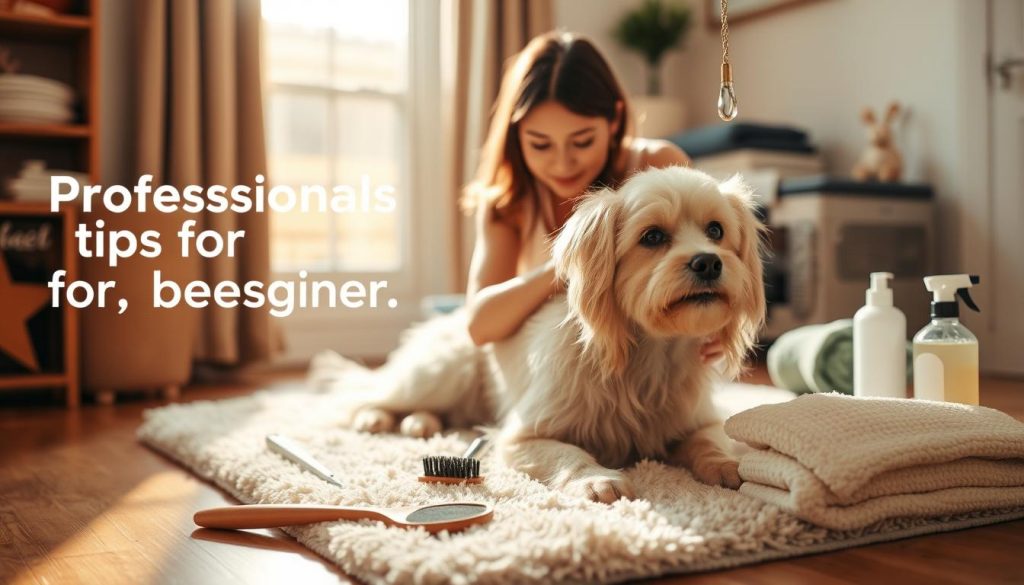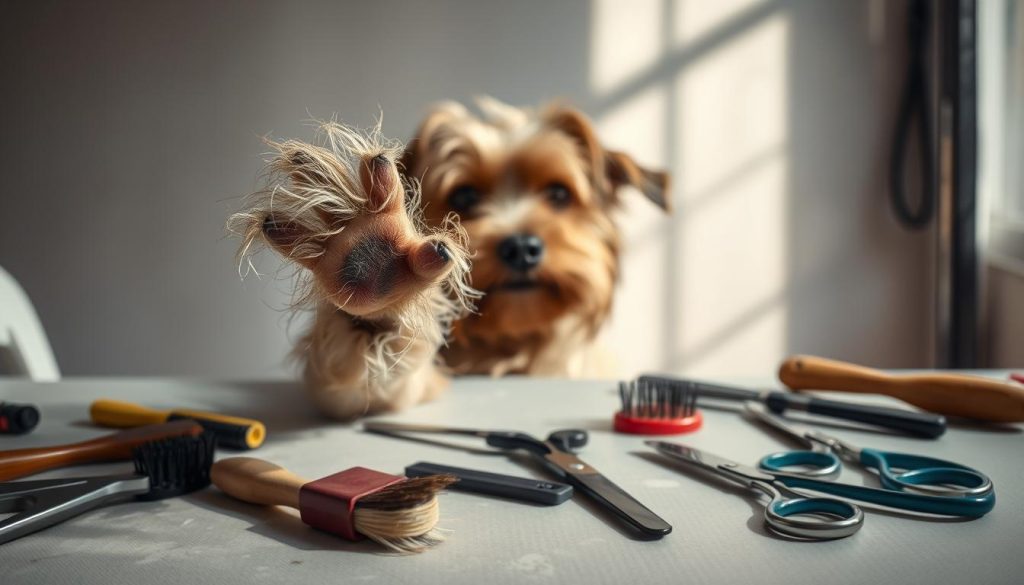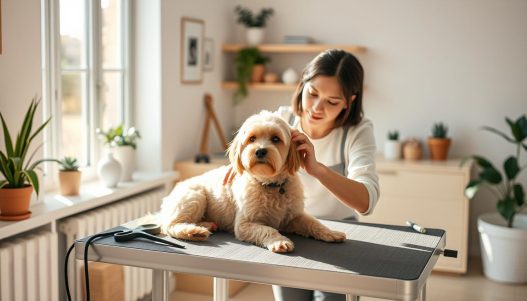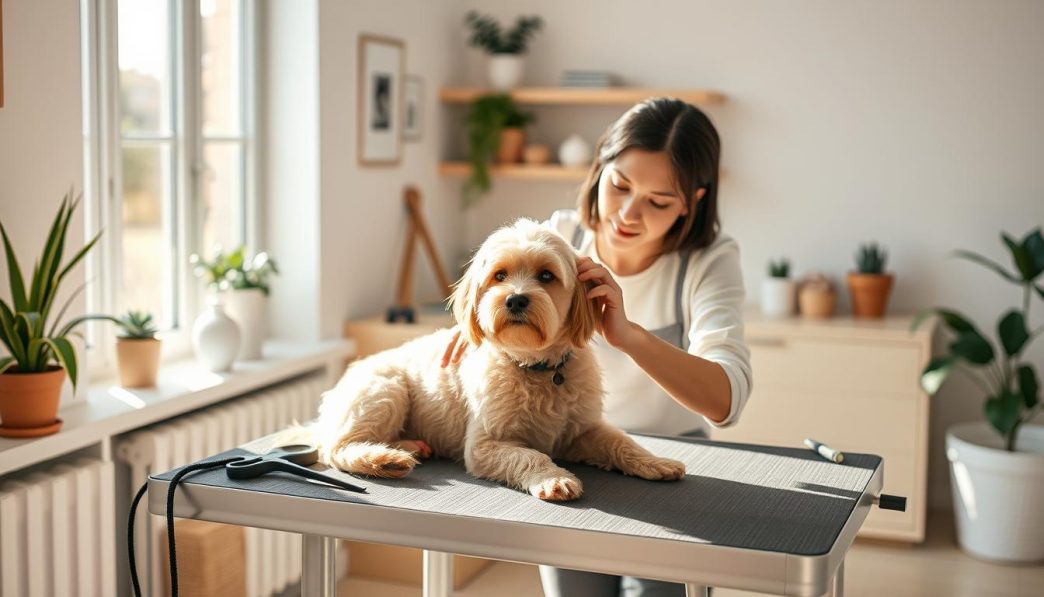As a pet owner, taking care of your furry friend’s hygiene is essential for their overall health and well-being. Home grooming is a great way to bond with your pet while keeping them clean and comfortable.
Professional tips can help you master the art of pet grooming in the comfort of your own home. By following simple techniques and using the right tools, you can keep your pet looking and feeling their best.
Key Takeaways
- Learn the basics of pet grooming for a healthy pet
- Discover simple home grooming techniques
- Understand the importance of regular grooming
- Find out how to choose the right grooming tools
- Get tips on creating a grooming routine
Getting Started with At-Home Pet Grooming
Embarking on at-home pet grooming can be a rewarding experience for both you and your pet. It not only helps in maintaining their hygiene and appearance but also strengthens your bond.
Benefits of Grooming Your Pet at Home
Grooming your pet at home has several advantages. Two significant benefits include cost savings and the opportunity to strengthen your bond with your pet.
Cost Savings and Convenience
At-home grooming eliminates the need for frequent visits to professional groomers, saving you money. It also offers the convenience of grooming your pet at a time that suits you and your pet’s schedule.
Strengthening Your Bond with Your Pet
Grooming is a personal and intimate activity that can significantly enhance the bond between you and your pet. The physical touch and attention help your pet feel loved and secure.
Understanding Your Pet’s Grooming Needs
Different pets have different grooming needs based on their breed, age, and health. Understanding these needs is crucial for effective at-home grooming.
Breed-Specific Requirements
Certain breeds require specific grooming techniques. For example, long-haired breeds need regular brushing to prevent matting, while short-haired breeds may require less frequent grooming.
Age and Health Considerations
Pets with certain health conditions or older pets may require adjusted grooming techniques. It’s essential to consider these factors to ensure grooming is a comfortable experience for your pet.
Essential Grooming Tools and Supplies
Effective pet grooming at home starts with assembling a comprehensive kit of necessary tools and supplies. Having the right equipment not only makes the grooming process easier but also ensures your pet’s safety and comfort.
Basic Grooming Kit for Dogs
A basic grooming kit for dogs should include a variety of tools tailored to your dog’s specific coat type and needs.
Brushes and Combs for Different Coat Types
Different breeds have different coat types, requiring specific brushes and combs. For example, slicker brushes are ideal for removing tangles and mats from long-haired breeds, while bristle brushes are better suited for short-haired dogs.
Clippers and Scissors
Clippers are essential for dogs that require regular haircuts, such as Poodles and Bichon Frise. Scissors, on the other hand, are useful for trimming around the face, ears, and paws.
Basic Grooming Kit for Cats
Cats also require regular grooming, though their needs differ from dogs. A basic feline grooming kit should include tools designed specifically for cats.
Specialized Feline Grooming Tools
For cats, grooming tools like grooming gloves and soft-bristle brushes are gentle on their skin and effective at removing loose hair.
Dealing with Shedding
Shedding is a common issue for many cat owners. Regular brushing with the right tools can significantly reduce the amount of shedding.
Quality vs. Cost: Where to Invest
When it comes to grooming tools, it’s essential to balance quality and cost. While cheaper tools might be tempting, investing in high-quality grooming tools can save money in the long run by reducing the need for frequent replacements.
| Grooming Tool | Quality Consideration | Cost |
|---|---|---|
| Brushes | Look for durable materials and comfortable grips. | $10-$50 |
| Clippers | Invest in clippers with adjustable blades and quiet operation. | $50-$100 |
| Nail Trimmers | Choose trimmers with sharp blades and ergonomic design. | $5-$20 |
Creating a Calm Grooming Environment
Establishing a calm environment is crucial for effective pet grooming at home. A stress-free space not only makes the grooming process easier but also strengthens the bond between you and your pet.
Setting Up Your Grooming Space
To create a conducive grooming environment, consider the layout and comfort of the space. Ensure it’s well-lit and free from distractions.
Safety Considerations
Remove any hazardous materials or objects that could harm your pet during grooming. Ensure the area is non-slippery to prevent accidents.
Comfort and Accessibility
Make sure the grooming area is easily accessible for your pet. Use a comfortable grooming table or mat to support your pet’s back and joints.
Techniques to Keep Your Pet Relaxed
Keeping your pet relaxed is key to a successful grooming session. Use gentle, soothing voice tones and positive reinforcement techniques to calm your pet.
Using Treats and Positive Reinforcement
Reward your pet with treats and praise during grooming to associate the experience with positive outcomes.
Timing Your Grooming Sessions
Keep grooming sessions short, especially for pets that are new to grooming. Gradually increase the duration as your pet becomes more comfortable.
By implementing these strategies, you can create a calm grooming environment that benefits both you and your pet, making grooming a positive experience.
Brushing Techniques for Different Coat Types
Understanding the right brushing techniques for your pet’s coat can make a huge difference in their grooming and overall health. Different pets have different coat types, each requiring a unique brushing approach.
Short-Haired Breeds
For short-haired breeds, brushing is primarily about removing loose fur and dander. A rubber brush or a bristle brush can be effective for this coat type, helping to distribute skin oils and keep the coat healthy.
Removing Loose Fur and Dander
Regular brushing with the right tool can significantly reduce shedding and prevent hair from getting everywhere in your home. It’s also a great way to bond with your pet.
Long-Haired Breeds
Long-haired breeds require more meticulous care to prevent tangles and mats. A slicker brush or a pin brush is ideal for gently working out knots without causing discomfort.
Preventing Tangles and Mats
Daily brushing is essential for long-haired pets. It not only keeps their coat looking beautiful but also prevents painful matting that can lead to skin irritation.
Double-Coated Breeds
Double-coated breeds have a unique coat structure that sheds heavily during certain times of the year. Managing seasonal shedding requires regular and thorough brushing with an undercoat rake or a shedding tool.
Managing Seasonal Shedding
Brushing your double-coated pet regularly can help reduce the amount of loose hair and prevent it from matting. It’s a process that requires patience and the right tools.
Dealing with Matted Fur
Matted fur can be painful for pets and challenging to resolve. Knowing when to cut vs. when to brush out mats is crucial for your pet’s comfort and safety.
When to Cut vs. When to Brush Out
For minor mats, gentle brushing with the right tool can resolve the issue. However, severe matting may require cutting the mat out, a task that should be done with care or by a professional to avoid hurting your pet.
Bathing Your Pet Like a Professional
Bathing your pet is an essential part of their grooming routine, and doing it like a professional can make all the difference.
Choosing the Right Shampoo
Selecting the appropriate shampoo for your pet is crucial. The right shampoo can help maintain your pet’s skin health and coat condition.
Understanding Pet Skin pH Balance
Pet skin has a different pH balance than human skin. Using a shampoo that’s formulated for pets ensures that their skin remains healthy and balanced.
Special Formulations for Skin Conditions
Some pets have specific skin conditions that require special shampoos. For instance, pets with allergies or irritated skin may benefit from hypoallergenic or medicated shampoos.
Step-by-Step Bathing Process
Bathing your pet involves more than just applying shampoo. Here’s a step-by-step guide to help you through the process.
Pre-Bath Preparation
Before the bath, brush your pet to remove any tangles or mats. This makes the bathing process smoother and less stressful for your pet.
Proper Washing Techniques
Use lukewarm water and apply shampoo carefully, avoiding sensitive areas like the eyes and ears. Massage the shampoo into your pet’s coat, then rinse thoroughly.
Drying Techniques That Won’t Stress Your Pet
Drying your pet after a bath is just as important as the bath itself. The right technique can help prevent stress and discomfort.
Towel Drying vs. Blow Drying
Towel drying is a gentle way to dry your pet, but for some breeds, blow drying on a low setting can be more efficient. Always be cautious and monitor your pet’s comfort level.
Keeping Your Pet Comfortable
Regardless of the drying method, ensure your pet is comfortable and not too cold or hot. A calm environment can significantly reduce stress.
| Bathing Technique | Benefits | Considerations |
|---|---|---|
| Towel Drying | Gentle, reduces stress | May not be as efficient for thick coats |
| Blow Drying | Efficient for thick coats | Can be stressful if not done carefully |
Pet Grooming at Home: Professional Tips for Beginners
As a beginner, grooming your pet at home can seem daunting, but with the right approach, it can become a rewarding experience for both you and your pet. Grooming is an essential part of pet care that not only keeps your pet clean but also strengthens your bond.
Establishing a Regular Grooming Routine
Creating a regular grooming routine is crucial for your pet’s health and hygiene. It helps in early detection of any skin issues or other health problems.
Creating a Grooming Schedule
To establish a successful grooming routine, start by creating a schedule that suits your pet’s needs. For instance, dogs with long hair may require daily brushing, while short-haired dogs might need brushing only a few times a week.
Tracking Your Pet’s Grooming Needs
Keep a record of your pet’s grooming activities to track their progress and identify any changes in their coat or behavior. This will help you adjust your grooming routine as needed.
Reading Your Pet’s Body Language
Understanding your pet’s body language is vital during grooming. It helps you identify signs of stress or discomfort, ensuring a positive experience.
Signs of Stress or Discomfort
Watch for signs such as growling, trying to move away, or flattening their ears. These are indicators that your pet is feeling stressed or uncomfortable.
When to Back Off and Try Later
If you notice any signs of stress, it’s best to stop the grooming session immediately and try again later when your pet is more relaxed.
Making Grooming a Positive Experience
Making grooming a positive experience is key to a successful routine. This can be achieved through reward systems and building trust over time.
Reward Systems That Work
Use treats and praise to reward your pet during and after grooming sessions. This positive reinforcement will help your pet associate grooming with positive experiences.
Building Trust Over Time
Consistency and patience are crucial in building trust. Over time, your pet will become more comfortable with the grooming process, making it a enjoyable experience for both of you.

Nail Trimming and Paw Care
Proper nail trimming and paw care are essential for your pet’s overall health and comfort. Neglecting these aspects of grooming can lead to discomfort, pain, and potentially serious health issues.
Safe Nail Trimming Techniques
Nail trimming is a delicate process that requires the right tools and techniques. It’s crucial to avoid cutting the quick, the sensitive part of the nail that contains nerves and blood vessels.
Different Tools: Clippers vs. Grinders
There are two primary tools for nail trimming: clippers and grinders. Clippers are more traditional and come in different sizes for various nail types. Grinders are ideal for smoothing out rough edges and are often considered safer for pets with dark nails.
- Clippers: Suitable for most pets, especially those with light-colored nails.
- Grinders: Ideal for pets with dark nails or for smoothing rough edges.
Finding the Quick in Light and Dark Nails
For pets with light-colored nails, the quick is visible as a pinkish area inside the nail. For dark nails, it’s more challenging; you’ll need to trim carefully and stop when you see a slight change in the nail’s texture or color.
Paw Pad Maintenance
Paw pad care involves more than just nail trimming. It includes checking and maintaining the health of the pads themselves.
Trimming Excess Fur Between Pads
Excess fur between the pads can cause discomfort and lead to matting. Use round-tipped scissors or clippers with a guard to trim this fur carefully.
Moisturizing Dry or Cracked Pads
Dry or cracked pads can be painful for pets. Apply a paw balm or moisturizer to keep them hydrated and healthy.
What to Do If You Cut the Quick
Accidents can happen even with the best care. If you cut the quick, remain calm and follow the proper steps.
Emergency Styptic Powder Application
Styptic powder is a must-have for nail trimming. It stops the bleeding and relieves pain when applied to the cut nail.
Monitoring for Infection
After cutting the quick, monitor the nail for signs of infection, such as redness, swelling, or discharge. If you notice any of these symptoms, consult your veterinarian.
Ear, Eye, and Dental Care Essentials
Regular ear, eye, and dental care can significantly enhance your pet’s overall health and happiness. Proper attention to these areas can prevent a multitude of health issues, ensuring your pet leads a comfortable and healthy life.
Cleaning Ears Safely
Ear care is a critical aspect of pet grooming. Cleaning your pet’s ears regularly can help prevent infections and other issues.
Recognizing Ear Problems
It’s essential to recognize the signs of ear problems, such as excessive scratching, redness, or discharge. If you notice any of these symptoms, consult your veterinarian for advice.
Proper Cleaning Solution Application
When cleaning your pet’s ears, use a gentle cleaning solution specifically designed for pets. Avoid inserting the applicator too far into the ear canal to prevent damage.
Eye Care and Tear Stain Prevention
Gentle eye care is vital for maintaining your pet’s eye health. Regular cleaning can help prevent tear stains and other issues.
Gentle Cleaning Techniques
Use a damp cloth or a cotton ball to gently wipe away any discharge or debris from your pet’s eyes. Be cautious not to touch the eye itself.
Breeds Prone to Eye Issues
Certain breeds, such as Pugs and Bulldogs, are more prone to eye problems due to their facial structure. Regular checks are crucial for these pets.
Basic Dental Hygiene for Pets
Dental hygiene is a crucial aspect of your pet’s overall health. Regular toothbrushing can help prevent tartar buildup and gum disease.
Introducing Toothbrushing
Start by gradually introducing your pet to the toothbrush and toothpaste. Make it a positive experience with praise and rewards.
Alternative Dental Care Options
If your pet resists toothbrushing, consider alternative dental care options such as dental chews or water additives.
Handling Challenging Grooming Situations
Dealing with anxious or senior pets during grooming demands a thoughtful and gentle strategy. As a pet owner, it’s essential to recognize the challenges that come with grooming pets that are nervous, elderly, or have special needs.
Working with Anxious or Fearful Pets
Anxious pets require a calm and patient approach. Desensitization training can be highly effective in helping your pet become more comfortable with the grooming process.
Desensitization Training
Desensitization involves gradually introducing your pet to the grooming tools and processes, starting with small, manageable steps. This helps reduce anxiety and makes grooming a more positive experience.
Using Calming Aids When Necessary
In some cases, calming aids such as pheromone diffusers or calming treats can be beneficial in reducing your pet’s stress during grooming.
Grooming Senior Pets
Senior pets have unique needs due to age-related changes. Accommodating arthritis and mobility issues is crucial for a comfortable grooming experience.
Accommodating Arthritis and Mobility Issues
Grooming sessions for senior pets should be shorter and more gentle, taking into account any physical limitations they may have.
Special Considerations for Older Skin and Coats
Older pets may have thinner skin and different coat conditions, requiring gentle products and techniques to avoid irritation.
When to Seek Professional Help
It’s essential to recognize your limitations as a pet owner and know when to seek professional help for challenging grooming situations.
Recognizing Your Limitations
If your pet’s anxiety or age-related issues make grooming too stressful, it may be time to consult a professional groomer.
Finding a Trustworthy Professional Groomer
Look for groomers with experience in handling anxious or senior pets. Ask for recommendations and check reviews to find a groomer who can provide the care your pet needs.
| Grooming Challenge | Solution |
|---|---|
| Anxious Pets | Desensitization training, calming aids |
| Senior Pets | Gentle grooming, accommodating mobility issues |
| Severe Grooming Issues | Seek professional grooming help |

Conclusion: Building Confidence in Your Pet Grooming Skills
Building pet grooming confidence takes time and practice. By following the tips outlined in this article, you can develop the grooming skills needed to keep your pet clean and healthy.
Establishing a regular grooming routine is key to becoming more comfortable with the grooming process. As you continue to groom your pet at home, you’ll become more confident in your abilities, and your pet will become more relaxed.
With patience and practice, you can master the art of pet grooming and strengthen the bond between you and your pet. Start with small steps, and don’t be afraid to seek professional help when needed.






